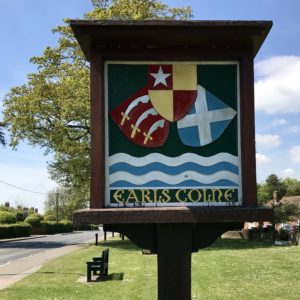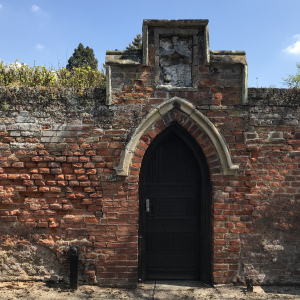The earl in question in William Byrd’s “Earl of Oxford March”
Ever wondered about the provenance of the famous Earl of Oxford’s March by the Elizabethan composer, William Byrd? He wrote it for the 17th Earl of Oxford, Edward de Vere, about whom I got some inside information when I visited my ailing sister in England last month.
 Evidently, the research bug hasn’t left me since I went in search of Sarah’s story for my forthcoming biographical memoir, Old New Worlds. When I was in England, I took myself on a walking tour of Earls Colne in Essex, where my sister settled about twenty miles from where Sarah’s husband grew up in the early 1800s. The earls in question in this little village on the banks of the river Colne (you don’t pronounce the “l”) are the twenty successive Earls of Oxford who were Lords of the Manor from 1141. Their heraldic symbol was a five-pointed star, which you can see in strategic places around the village, like this board on the village green.
Evidently, the research bug hasn’t left me since I went in search of Sarah’s story for my forthcoming biographical memoir, Old New Worlds. When I was in England, I took myself on a walking tour of Earls Colne in Essex, where my sister settled about twenty miles from where Sarah’s husband grew up in the early 1800s. The earls in question in this little village on the banks of the river Colne (you don’t pronounce the “l”) are the twenty successive Earls of Oxford who were Lords of the Manor from 1141. Their heraldic symbol was a five-pointed star, which you can see in strategic places around the village, like this board on the village green.
At first glance, the buildings along the High Street don’t appear to be as ancient as the tenure of the earls would suggest, but the “House Detectives” Trail devised by the Earls Colne Parish Council guided me to clues of the true medieval period. The local grocery store, for instance, is made up of two medieval houses, and when the Co-op was last refurbished in 1983, a section of the ceiling was left open so that the rafters are clearly visible if you know to look up—as here, in the produce section.

A little further east from the Co-op is an alleyway where you can see, set into the side of the building, a small medieval window, which is the only clue to the 14th century timber frame that has been covered with plaster cladding over the rest of the wall.
 Across the street, is an attractive Regency terrace—but it had been converted from an Elizabethan mansion that was built in 1585. When I explored behind the façade, hoping I wasn’t trespassing, I found a nest of old roofs from the earlier period (I believe that is a rather more contemporary dovecote in the foreground.)
Across the street, is an attractive Regency terrace—but it had been converted from an Elizabethan mansion that was built in 1585. When I explored behind the façade, hoping I wasn’t trespassing, I found a nest of old roofs from the earlier period (I believe that is a rather more contemporary dovecote in the foreground.)
A bit further east on this side of the road is the only early building in Earls Colne that looks, aside from the windows and door, pretty much as it did when it was first build in 1520. Notice the projecting “jetty” of the upper floor, which was a typical feature of the period.
The focal point of the High Street is St Andrew’s Parish Church, built on the site of a church that had stood there before 1100. The impressive tower of the present church dates from the time of John de Vere, the 15th Earl of Oxford (c. 1482 – 1540) who was the first Protestant to take the title. He was knighted by Henry VIII and attended the king in battle, but Henry’s imprint on Earls Colne is a destructive one. He didn’t only play fast and loose with his six wives, he also suppressed the Catholic monasteries in the 1530s and took their land. This was the fate, too, of the Earls Colne Priory, which had been built during the time of Aubrey de Vere in the early 1100s, and, over time, it gradually fell into ruin. Unusually, though, the lands were returned to the de Veres—possibly because of John de Vere’s service to the king, possibly because the family tombs were there. Above this small doorway in the boundary wall of the old priory is a fragment from the tomb of the Eighth Earl of Oxford who died in 1371.
 The title of the Earl of Oxford, the second longest in British peerage, is now dormant, but the de Vere family held the entitlement for more than five and a half centuries, until the death of the 20th earl in 1703. It’s fair to say I think that the most famous Earl of Oxford was the 17th, Edward de Vere, because of the Oxfordian theory, claiming that the earl was the author of William Shakespeare’s plays. The dates coincide—Edward de Vere: 1550-1604, Shakespeare: 1564-1616—but I can’t be a subscriber to that view. As Dominic Dromgoole, the former artistic director of the Globe Theatre, facetiously wrote in The New York Times Book Review, “In the world of these high priests [of Shakespearean arcana], nothing can be what it seems … and finally, of course, we tumble into the monumental blindness to reality of the authorship question. Shakespeare cannot be Shakespeare, because he was.” Still, I have to say, learning that Edward de Vere was from this line of Earls of Oxford—and making the connection that William Byrd wrote his march for him—made my exploration of Earls Colne that much more intriguing.
The title of the Earl of Oxford, the second longest in British peerage, is now dormant, but the de Vere family held the entitlement for more than five and a half centuries, until the death of the 20th earl in 1703. It’s fair to say I think that the most famous Earl of Oxford was the 17th, Edward de Vere, because of the Oxfordian theory, claiming that the earl was the author of William Shakespeare’s plays. The dates coincide—Edward de Vere: 1550-1604, Shakespeare: 1564-1616—but I can’t be a subscriber to that view. As Dominic Dromgoole, the former artistic director of the Globe Theatre, facetiously wrote in The New York Times Book Review, “In the world of these high priests [of Shakespearean arcana], nothing can be what it seems … and finally, of course, we tumble into the monumental blindness to reality of the authorship question. Shakespeare cannot be Shakespeare, because he was.” Still, I have to say, learning that Edward de Vere was from this line of Earls of Oxford—and making the connection that William Byrd wrote his march for him—made my exploration of Earls Colne that much more intriguing.










2 Responses to The earl in question in William Byrd’s “Earl of Oxford March”